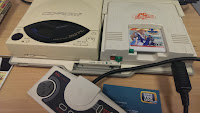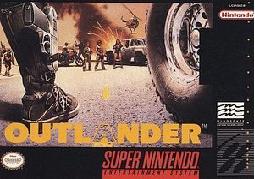 Where would we be without electronics? Using Electrical circuitry to solve problems for a variety of requirements by means of semiconductor components to control electrons, it’s such common thing that it’s mostly taken for granted, and rarely is it celebrated.
Where would we be without electronics? Using Electrical circuitry to solve problems for a variety of requirements by means of semiconductor components to control electrons, it’s such common thing that it’s mostly taken for granted, and rarely is it celebrated.
In July,
GamesYouLoved were lucky enough to be invited along to the
Silicon Dreams in the heart of Leicestershire, to celebrate, remember and learn about the age of electronics and hopefully understand its future. A month after the event, after all the computers, components and gadgets have been packed away or taken back to the museums from whence they came, and the dust once again settles on the diodes, we take a retrospective look at the event and what made it tick.
The event was held at
Snibston Discovery Museum in Ashby, in the heart of Leicestershire. The purpose of the event, as the name suggests; to celebrate the ‘age of the silicon chip’, and the evolution of electronic entertainment. It featured an extensive list of exhibitors; from from collectors and completionists to originators and tech-geeks, all keen to share their knowledge and let punters ask questions and interact with their exhibits. The weekend was packed with a variety of activities and talks from key speakers of the computing world. The exhibitor list read like a who’s who in British computing, featuring not one but two of UK’s computing museums; the
Centre for Computing History, and Retro Computer Museum, featured talks and input from some of the scene’s most respected minds and even included entertainment from 80’s electro popsters
Heaven 17. This was right up
GamesYouLoved’s street.
The location couldn’t be more apt, with the event spread nicely throughout the technology museum, which itself hosts a range of science and industry exhibits. GamesYouLoved attended the event on an unusually scorching Saturday, but despite the Barbeque weather the place was a hive of activity with people of all ages enthusiastically exploring and interacting. Exhibits provided an extensive history of computing, showcasing pretty much every computer and console one could remember and many you probably wouldn’t. From the education based Commodore PET 201 (Personal Electronic Transactor) and BBC micros to countless consoles and game systems. Bits of nostalgia were dotted everywhere whisking you back to a day when electronic entertainment was still fresh and exciting, from classic synths, the first games systems (Binatone TV Master) to Betamax top-loading video players.
 GamesYouLoved asked Simon Hewitt (Event Organiser) where it all started:
GamesYouLoved asked Simon Hewitt (Event Organiser) where it all started:
“The clientele that came to vintage computer festival 2 years ago, wanted a similar or follow-up event that celebrated old computers and the legacy of the silicon chip rather than just gaming. We wanted to achieve all of that and make it appeal to a family audience also.”
The next event did just that, by bringing together various factions of the computing community and guest speakers, to demonstrate what their remit was all about and share their passion to potential new audiences. "It doesn't stop there - we'll also have film-related entertainment, arts activities and - of course - electronic music.”, the website promotes.
Simon had worked hard to bring it all together, and the smooth running of the event was down to Simon and his crew’s hard work and determination.
“It’s all really exciting..” Simon enthuses, “..We’ve got a talk from Martin Ware of Heaven 17, one of the godfathers of British electronic music. We’re following this up with a live performance by a band called Northern Kind- a newer synth duo along the same lines, and rounding things off with a performance by Heaven 17. It’s a way to wind down and relax after overseeing things throughout the day as well as adding a bit of a ‘rock and roll’ element. It’s also in keeping with the retro theme of the event.”
And the Simon’s favourite game?
“We’ve had a comp running on Chuckie Egg and that was always a favourite of mine. I had an Acorn Electron and a Spectrum and I preferred the Spectrum version. I’ve even got it on my android phone!
Whilst there,
GamesYouLoved GamesYouLoved spent several hours getting involved in the extensive collection of computing systems. Limited run or unsuccessful systems are a part of the evolution of the home entertainment system and
GamesYouLoved always find these more interesting because they often still had a part to play in the scene as a whole. We all may remember the likes of Atari’s Jaguar or Panasonic’s 3DO - but perhaps less the French cassette based systems: Matra Alice 90 (a Tandy TRS-80 clone) or an Exelvision Exl 100, or Micronique Hector 2HR, or Philips VG5000.
 Moving around the event GamesYouLoved asked the owner of these (and many more gems), Steve Perry, about his collection:
Moving around the event GamesYouLoved asked the owner of these (and many more gems), Steve Perry, about his collection:
“I've brought a variety of systems along. I just think it’s important that people see them and get chance to use them. A lot of collectors keep their stuff hidden away, stored in boxes, never sharing them and I don’t really agree with that. It’s important for the scene as a whole, and I know you’ve got emulators but it can never replace the look and feel of interacting with the real thing. I’ll always prefer to play on the real thing. I suppose it’s like watching something important on television. It’s always gonna be better to watch it live than a recording.
I’ve probably got about 130 systems at the moment give or take a few non-working ones. Ive got 3 full size arcade cabinets in the living room…”
GamesYouLoved then asked Steve Perry where it all started for him?
“I guess it all started at a
RetroVision event, one of the first retro gaming events. It was all quite Llamasoft based with Jeff Minter, and as a homage to his games a group of people from the YakYak forum, started this event called RetroVision and over the years it got more and more generic incorporating different games, different consoles and systems. I went to one in Oxford, took along a Playstation 2, just the one system. The next event I took a few more systems along, and then more after that and it’s just grown, and kind of got out of control.”
 Back to the event...
Back to the event...

The event was also a great way of promoting the hard work of 2 museums, who are currently playing a big part in Britain’s growing retro games scene.
Centre for Computing History, and Retro Computer Museum both have extensive collections of computing and gaming systems from years gone by.
Centre for Computing History is a registered charity and has only recently found a home in Haverhill near Cambridge. Their aim is to not only celebrate the impact computing has made on the way we communicate and absorb information, but to generate interest in computing and programming in the younger generations. This made them a perfect exhibitor for the event, as not only did they bring along an array of classic hardware, but they could inform and engage visitors with relevant knowledge and information.
Retro Computer Museum or RCM were also integral to the event supplying an extensive selection of home computing and gaming systems, all set-up and ‘ready to go’ allowing visitors to lose themselves completely in retro gaming if they so wished. Andy Spencer was good enough to give us a walk around and background on all the machines they’d brought from their base in Leicester. His passion and enthusiasm was infectious reminding
GamesYouLoved of what gaming of old is really about. Similar to the
Centre for Computing History RCM are also a charity relying on donations and the hard work of volunteers to sustain itself.
GamesYouLoved also spoke to Dylan Smith, who had devised an Ethernet networking system for the Sinclair Spectrum, allowing for LAN multiplayer gaming. The theme of the event was becoming more prevalent the more involved
GamesYouLoved got. Old meets new. Sure, it’s important not to forget where computing’s come from also applying a fresh approach, simple and exciting things can occur.
GamesYouLoved also spoke to Chris Smith, writer of the book ‘The ZX Spectrum ULA: How to design a microcomputer’
He went on to say

“There’s still a barrier, especially with the younger generation, using this equipment. So what I decided to do, by way of investigating the ULA- the custom chip in the spectrum, I managed to build my own spectrum, using basic principles using common parts you can find in places like Maplin.
This celebrates how the spectrum chip works, because there’s not really any documentation for that. I then documented this into a book, documenting the whole design. This examines not just the ULA, but looks at how an 8bit computer was designed in the 80’s using the spectrum as the case-study.”
I asked whether he thought gaming had a part to play in all this. Surely gaming helped get the most out of the hardware and push things?
“In gaming, especially when you’ve got such limited resources, whether the ZX spectrum or any 8-bit machine from that era, producing games which had playability and were better than the last was key. It was all about improving and producing things that were better so things didn’t stagnate, you had to innovate.”
Chris himself used to work for the developer
MicroGen and would keep an eye on the gaming scene because of its importance to the Spectrum scene;
“I used to subscribe to Crash magazine. Bearing in mind that at the time there was no internet and no ‘in your face reporting’, I would buy the magazines to keep up with what people were doing in advancements in games. .”
And when
GamesYouLoved asked about his favourite gaming memories:
“I used to play some games on the spectrum but it was more to gauge what programmers were doing. I s’pose I was more of a watcher than a player. If I was pushed though, my favourite game would be either Sabre Wulf or Nightlore. I played Sabre Wulf and awful lot. Scuba Dive (Durrell)? I loved that game. And Stop The Express.”
Since the event, The Centre for Computing History has opened its doors and Simon has confirmed there will be another Silicon Dreams event. Simon is currently looking for sponsors for the 2014 event and is providing up to date news about the progress of things via the website:
http://www.silicondreams.org.uk/ and their Twitter page:
twitter.com/SiliconDreamsGB
Thank you to everyone who help organise and contributed to the Silicon Dreams event from the
GamesYouLoved Team
Find
The Centre for Computing History and
Retro Computer Museum on our friends page:
http://www.gamesyouloved.com/friends/
 For many of us the Neo Geo was untouchable at home, the closest we got to it was maybe in the arcades where we played the fast and furious array of games on a Neo Geo Arcade cabinet. Perhaps someone’s older, richer brother had a AES – but they then maybe sold it on for it was an investment as much as a video games console.
For many of us the Neo Geo was untouchable at home, the closest we got to it was maybe in the arcades where we played the fast and furious array of games on a Neo Geo Arcade cabinet. Perhaps someone’s older, richer brother had a AES – but they then maybe sold it on for it was an investment as much as a video games console.  Away from home play this is where the Neo Geo X comes into its own. Not only can you take it (with over 5 hours gaming time of one charge) on the train, bus, coffee shop or to a family event where you need some ‘gaming me time!’
Away from home play this is where the Neo Geo X comes into its own. Not only can you take it (with over 5 hours gaming time of one charge) on the train, bus, coffee shop or to a family event where you need some ‘gaming me time!’ It also acts a handheld console that plays directly into the HDMI connection into a TV. This was particularly cool when we have been on a road trip to some events where an overnight stay means the usual TV channels and no much else on. Our delight was hooking this up to the 50" TV in the room and playing hardcore Neo Geo games like Samurai Showdown and Fatal Fury before a gaming event. What else could you ask for..
It also acts a handheld console that plays directly into the HDMI connection into a TV. This was particularly cool when we have been on a road trip to some events where an overnight stay means the usual TV channels and no much else on. Our delight was hooking this up to the 50" TV in the room and playing hardcore Neo Geo games like Samurai Showdown and Fatal Fury before a gaming event. What else could you ask for..

















